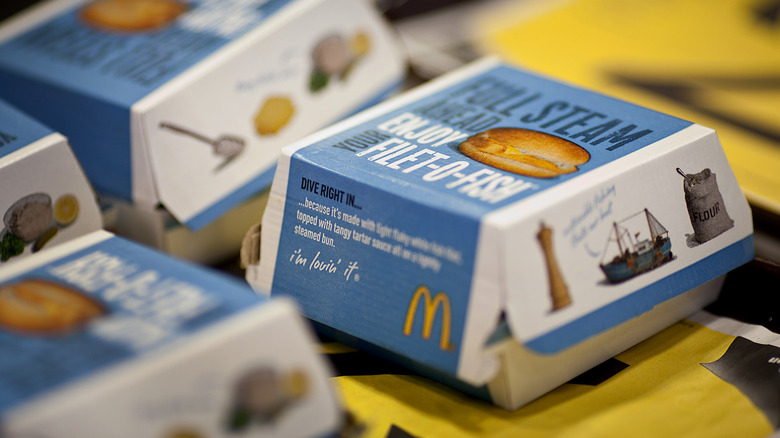McDonald's Filet-O-Fish Might Be Fresher Than You Think
An unlikely hit at the restaurant, McDonald's Filet-O-Fish sandwich is a far cry from the burgers and chicken found at most other fast-food chains. While the menu offering is most popular during the Lenten season, a time when Catholics typically avoid eating meat on Fridays, the sandwich is actually available all year long. According to the chain's preceding Manager of Culinary Innovation Mike Haracz, the sandwich is a whole lot fresher than many people are aware of.
Haracz has made quite a name for himself on TikTok, where he frequently answers questions and provides greater insight into McDonald's and its practices. When asked for his opinion of the restaurant's only fish sandwich, he cleared up many common misconceptions, particularly regarding freshness. Haracz explained that the fish that makes up the sandwich is processed within just a few hours of being caught. He also highlighted the sustainable practices the chain uses when it comes to sourcing its fish, which may come as a surprise to many.
Diving into McDonald's Filet-O-Fish process
Chef Haracz provided lots of detail on how McDonald's catches and processes its famous fish sandwich. Per the chef, the Filet-O-Fish is made with wild-caught Alaska pollock instead of being farmed fish. After catching the Alaska pollock, workers on the boat process the fish and freeze the filets immediately to preserve freshness. Next, the frozen filets are transported to a special facility that processes them further. At this facility, the fish is cut into their iconic square shape, breading is applied, and the filets are par-fried, which entails partially frying the filets before they're frozen one more time.
@chefmikeharacz Replying to @Fresh God Wanna know something about #McDonalds #Filetofish sandwich? #mcdonaldsfiletofish #filetofishsandwich #filetofishchallenge #filetofishrecipe #McDonaldsFish #mcdonaldsfishfillet #mcdonaldsfishfilet #FYP
Finally, the frozen filets then make their way to various McDonald's locations, where they can be prepared for hungry customers. According to Haracz, the Filet-O-Fish consists of "whole muscle," unlike the chain's McNuggets, which consist of chicken that is broken down and molded into the familiar shape. Haracz also claimed that the restaurant is cognizant of overfishing, which is a major environmental issue that negatively affects fish populations.
McDonald's is serious about sustainability
As explained on the McDonald's website, it appears that Chef Haracz's claims about the chain are pretty accurate when it comes to fishing practices. All locations within the U.S. offer fish sandwiches certified by the Marine Stewardship Council, a nonprofit that supports ocean preservation by stamping certain products with a seal of approval, which then signals to consumers that a selection is sustainable. Additionally, the restaurant aims to avoid waste by making use of all parts of the Alaska pollock it sources to create Filet-O-Fish sandwiches.
Bycatch is another pertinent environmental issue McDonald's is passionate about. Bycatching is the process of inadvertently catching other types of aquatic life, which can greatly harm populations of fish, turtles, and other creatures that call the sea home. The fishery that works on behalf of the restaurant employs a "low bycatch" process as it sources Alaska pollock, which means that the yearly bycatch percentage is under 1%. These steps show that the fast-food establishment is just as concerned with environmental preservation as it is with providing quality food to diners.


